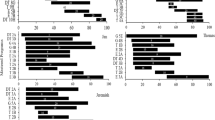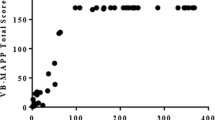Abstract
The present study sought to examine the relationships between two language assessments and a psychometrically validated adaptive behavior scale. The assessments evaluated included the Promoting the Emergence of Advanced Knowledge Relational Training System - Direct Training Module (PEAK-DT), the Assessment of Basic Language and Learning Skills – Revised (ABLLS-R), and the Vineland Adaptive Behavior Scales, second edition (VABS-II). The assessments were completed for 21 children diagnosed with autism. Results indicate a significant correlation between scores on the PEAK-DT and ABLLS-R (r = 0.951, p < 0.001, PEAK-DT and VABS-II (r = 0.453, p < .05), as well as the ABLLS-R and VABS-II (r = 0.563, p < 0.05). The results did not indicate any ceiling effects amongst any of the assessments. These results extend research on the psychometric properties of these assessment tools and provide implications for practitioner choice of curricula.



Similar content being viewed by others
References
Autism and Developmental Disabilities Monitoring (ADDM) Network Surveillance Year, and 2010 Principal Investigators (2014). Prevalence of autism spectrum disorder among children aged 8 years-autism and developmental disabilities monitoring network, 11 sites, United States, 2010. Morbidity and mortality weekly report. Surveillance summaries (Washington, DC: 2002), 63(2), 1.
Centers for Disease Control and Prevention. (2014). CDC estimates 1 in 68 children has been identified with autism spectrum disorder. Retrieved from http://www.cdc.gov/media/releases/2014/p0327-autism-spectrumdisorder.html. Accessed 15 June 2016.
Dixon, M. R. (2014a). The PEAK relational training system: direct training module. Carbondale, IL: Shawnee Scientific Press.
Dixon, M. R. (2014b). The PEAK relational training system: generalization module. Carbondale, IL: Shawnee Scientific Press.
Dixon, M. R. (2015). The PEAK relational training system: equivalence module. Carbondale, IL: Shawnee Scientific Press.
Dixon, M. R., Small S., L., & Rosales, R. (2007). Extended analysis of empirical citations with Skinner's verbal behavior: 1984–2004. The Behavior Analyst., 30(2), 197–209.
Dixon, M. R., Carman, J., Tyler, P. A., Whiting, S. W., Enoch, M., & Daar, J. H. (2014a). PEAK relational training system for children with autism and developmental disabilities: correlations with Peabody picture vocabulary test and assessment reliability. Journal of Developmental and Physical Disabilities, 26(5), 603–614.
Dixon, M. R., Whiting, S. W., Rowsey, K., & Belisly, J. (2014b). Assessing the relationship between intelligence and the PEAK relational training system. Research in Autism Spectrum Disorders, 8(9), 1208–1213.
Dixon, M. R., Belisle, J., Stanley, C., Rowsey, K., Daar, J. H., & Szekely, S. (2015). Toward a behavior analysis of complex language for children with autism: evaluating the relationship between PEAK and the VB-MAPP. Journal of Developmental and Physical Disabilities, 27, 223–233.
Dunn, L. M., & Dunn, D. M. (2007). The peabody picture vocabulary test, fourth edition. Bloomington, MN: NCS Pearson, Inc.
Dymond, S., O'Hora, D., Whelan, R., & O'Donovan, A. (2006). Citation analysis of Skinner's verbal behavior: 1984–2004. The Behavior Analyst., 29(1), 75–88.
Furniss, F. (2009). Assessment methods. In J. L. Matson (Ed.), Applied behavior analysis for children with autism spectrum disorders (pp. 33–66). New York: Springer.
Illinois State Board of Education. (2013). Illinois early learning and development standards. Retrieved from http://www.isbe.state.il.us/earlychi/pdf/early_learning_standards.pdf. Accessed 10 October 2016.
Mahmood, H., Saleemi, M., Hashim Riaz, Y. H., & Khan, F. (2015). Coping strategies of mothers with ASD children. Professional Medical Journal, 22(11).
Odom, S. L., Boyd, B. A., Hall, L. J., & Hume, K. (2010). Evaluation of comprehensive treatment models for individuals with autism spectrum disorders. Journal of Autism and Developmental Disorders, 40(4), 425–436.
Ontario Ministry of Child and Youth Services. (2016). Programs and services for children with autism. Retrieved from: http://www.children.gov.on.ca/htdocs/English/specialneeds/autism/programs.aspx. Accessed 15 June 2016.
Ontario Ministry of Child and Youth Services. (n.d.). The Autism parent resource kit. Retrieved from: http://www.children.gov.on.ca/htdocs/English/documents/specialneeds/autism/aprk/Autism_Parent_Resource_Kit.pdf. Accessed 15 June 2016.
Partington, J. W. (2008). The assessment of basic language and learning skills-revised (the ABLLS-R). Pleasant Hill, CA: Behavior Analysts, Inc.
Pearson Education. (2014). Vineland Adaptive Behavior Scales, Second Edition(Vineland™-II) Retrieved from: http://www.pearsonclinical.com/psychology/products/100000668/vineland-adaptive-behavior-scales-second-edition-vineland-ii-vinelandii.html?Pid=Vineland-II#tab-details
Perry, A., Flanagan, H. E., Geier, J. D., & Freeman, N. L. (2009). Brief report: the Vineland adaptive behavior scales in young children with autism spectrum disorders at different cognitive levels. Journal of Autism and Developmental Disorders, 39(7), 1066–1078.
Reed, D. D., & Luiselli, J. K. (2016). Promoting the emergence of advanced knowledge: a review of peak relational training system: direct training module by mark R Dixon. Journal of Applied Behavior Analysis, 49(1), 205–211. doi:10.1002/jaba.281.
Sautter, R. A., & Le Blanc, L. (2006). Empirical applications of Skinner’s analysis of verbal behavior with humans. The Analysis of Verbal Behavior, 22, 35–48.
Skinner, B. F. (1957). Verbal behavior. New York: Appleton-Century-Crofts.
Sundberg, M. L. (2008). Verbal behavior milestones assessment and placement program. Concord, CA: AVB.
Wagner, A., Lecavalier, L., Arnold, L. E., Aman, M. G., Scahill, L., Stigler, K. A., et al. (2007). Developmental disabilities modification of the Children’s global assessment scale. Biological Psychiatry, 61(4), 504–511.
Wong, C., Odom, S. L., Hume, K. A., Cox, A. W., Fettig, A., Kucharczyk, S., et al. (2015). Evidence-based practices for children, youth, and young adults with autism spectrum disorder: a comprehensive review. Journal of Autism and Developmental Disorders, 45(7), 1951–1966.
Acknowledgments
The author would like to thank the dedicated group of professionals at Surrey Place Centre, Toronto, ON for their help in gathering the data for this project.
Author information
Authors and Affiliations
Corresponding author
Ethics declarations
Funding
This study was not funded by any entity.
Ethical Approval
All procedures performed in this project were in accordance with the ethical standards of the institutional and/or national research committee and with the 1964 Helsinki declaration and its later amendments or comparable ethical standards.
Informed Consent
Informed consent was obtained from all individual participants, guardians, and/or agencies that are included in the study.
Conflict of Interest
The second author receives small royalties from sales of the PEAK curriculum. The first, third and fourth authors declare that they have no conflict of interest.
Disclosure
Second author receives small royalties from sales of the PEAK curriculum.
Rights and permissions
About this article
Cite this article
Malkin, A., Dixon, M.R., Speelman, R.C. et al. Evaluating the Relationships between the PEAK Relational Training System – Direct Training Module, Assessment of Basic Language and Learning Skills – Revised, and the Vineland Adaptive Behavior Scales – II. J Dev Phys Disabil 29, 341–351 (2017). https://doi.org/10.1007/s10882-016-9527-8
Published:
Issue Date:
DOI: https://doi.org/10.1007/s10882-016-9527-8




